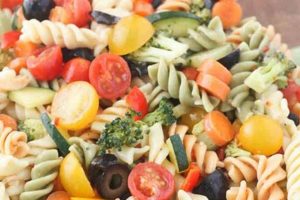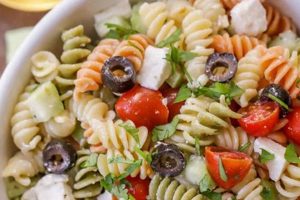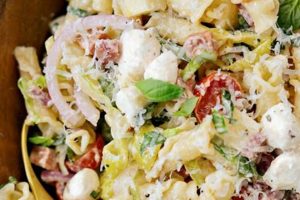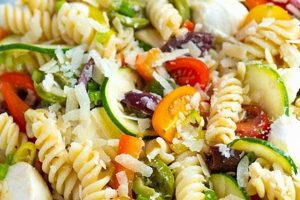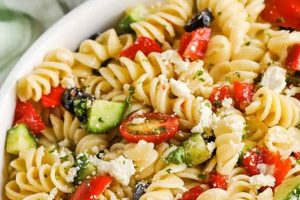Dishes featuring pasta salad traditionally rely on high-carbohydrate ingredients like semolina pasta. A healthier alternative focuses on reducing carbohydrate content through substitutions such as legume-based or vegetable-based noodles, resulting in a lighter meal option. For instance, a dish might combine spiralized zucchini or shirataki noodles with a vinaigrette dressing, fresh vegetables, and lean protein.
Reducing carbohydrate intake can be beneficial for weight management and blood sugar control. This approach to pasta salad allows individuals to enjoy a classic dish while aligning with dietary goals. Historically, pasta salads have been a popular dish for their versatility and ease of preparation, but the rise in health-conscious eating has led to innovative adaptations like the low-carbohydrate version.
This article will explore various aspects of creating these healthier pasta salads, including ingredient selection, preparation methods, nutritional information, and creative recipe ideas.
Tips for Creating Delicious Low-Carbohydrate Pasta Salads
Creating a satisfying and flavorful low-carbohydrate pasta salad requires careful consideration of ingredients and preparation techniques. The following tips offer guidance for achieving optimal results.
Tip 1: Choose the Right Pasta Substitute: Selecting an appropriate low-carbohydrate pasta alternative is crucial. Options include shirataki noodles, kelp noodles, spiralized vegetables (zucchini, carrots, etc.), or legume-based pasta. Each option offers a unique texture and flavor profile.
Tip 2: Blanch Vegetables Strategically: Blanching vegetables like broccoli or green beans enhances color and texture while ensuring they maintain a slight crispness in the salad. Overcooking can lead to a mushy consistency.
Tip 3: Focus on Flavorful Dressings: A vibrant dressing is essential for elevating the flavors of the salad. Consider options like pesto, lemon vinaigrette, or a creamy avocado-based dressing.
Tip 4: Incorporate High-Quality Protein: Adding lean protein such as grilled chicken, shrimp, or tofu enhances the nutritional value and creates a more substantial meal.
Tip 5: Add Healthy Fats: Incorporating healthy fats through ingredients like avocado, olives, or nuts contributes to satiety and flavor complexity.
Tip 6: Season Generously: Don’t be afraid to experiment with herbs, spices, and seasonings to create a well-balanced flavor profile. Fresh herbs like parsley, dill, or mint can brighten the dish.
Tip 7: Chill Thoroughly Before Serving: Allowing the salad to chill in the refrigerator for at least 30 minutes allows the flavors to meld and creates a more refreshing experience.
By following these tips, one can create delicious and healthy low-carbohydrate pasta salads that offer a satisfying alternative to traditional recipes. These dishes offer versatility for meal prepping and can be customized to individual preferences.
This information provides a solid foundation for exploring specific recipe ideas and further refining culinary skills in the realm of low-carbohydrate cooking.
1. Pasta Alternatives
The cornerstone of a successful low-carbohydrate pasta salad lies in selecting a suitable pasta alternative. Traditional pasta, made from durum wheat, contributes significantly to the carbohydrate content of a dish. Substituting this with lower-carbohydrate options allows individuals to enjoy the familiar format of a pasta salad while adhering to dietary restrictions or preferences.
- Vegetable Noodles:
Vegetables like zucchini, carrots, and squash can be spiralized or julienned to create noodle-like shapes. These offer a naturally low-carbohydrate base with a slightly crisp texture. Zucchini noodles, for example, pair well with lighter, brighter flavors like lemon and pesto. Their mild flavor makes them versatile, accepting a wide range of dressings and other ingredients.
- Legume-Based Pasta:
Pasta made from lentils, chickpeas, or black beans provides a higher protein and fiber content compared to traditional pasta. This contributes to increased satiety and offers a more substantial texture. Lentil pasta, for instance, works well with bolder flavors and heartier sauces. However, the distinct flavor profiles of legume-based pasta should be considered when pairing with other ingredients.
- Shirataki Noodles:
Made from konjac yam, shirataki noodles are extremely low in carbohydrates and calories. Their translucent appearance and gelatinous texture offer a unique experience. Shirataki noodles absorb flavors well but require careful preparation, including rinsing and blanching, to minimize a potentially unpleasant odor. They are best suited for Asian-inspired dishes or salads with strong flavors.
- Kelp Noodles:
Derived from seaweed, kelp noodles are another low-carbohydrate and low-calorie option. They offer a neutral flavor and a slightly crunchy texture. Kelp noodles require minimal preparation and work well in salads with light, refreshing dressings and ingredients. Their subtle flavor allows other components of the salad to shine.
The choice of pasta alternative influences the overall flavor profile and nutritional content of the dish. Carefully considering the characteristics of each option allows for strategic pairing with other ingredients, resulting in a balanced and satisfying low-carbohydrate pasta salad.
2. Vegetable Selection
Vegetable selection plays a crucial role in the overall composition and nutritional value of a low-carb pasta salad recipe. The choice of vegetables impacts not only the flavor and texture but also the carbohydrate content and micronutrient density of the final dish. Cruciferous vegetables like broccoli and cauliflower offer low carbohydrate content and valuable nutrients. Leafy greens such as spinach and kale contribute vitamins and minerals while adding minimal carbohydrates. Choosing a variety of colorful vegetables ensures a balanced nutrient profile and enhances visual appeal.
Consider the interplay between the chosen pasta alternative and the selected vegetables. For instance, a spiralized zucchini pasta salad benefits from the addition of lighter vegetables like cherry tomatoes, bell peppers, and cucumbers, creating a refreshing and summery dish. Conversely, a heartier legume-based pasta might pair well with roasted vegetables like Brussels sprouts, eggplant, and onions. This combination offers a more robust flavor profile and a satisfying textural contrast. Selecting vegetables with complementary flavors and textures enhances the overall culinary experience.
Strategic vegetable selection contributes significantly to a successful low-carb pasta salad. Prioritizing nutrient-dense, low-carbohydrate options enhances the health benefits of the dish. Furthermore, considering the flavor and texture profiles of various vegetables ensures a balanced and enjoyable meal. A well-composed low-carb pasta salad offers both nutritional value and culinary satisfaction. Thoughtful vegetable choices maximize these attributes and contribute to a well-rounded and flavorful dish.
3. Protein Choices
Protein choices significantly impact the nutritional profile and overall satisfaction derived from a low-carb pasta salad recipe. Protein adds satiety, contributing to a more substantial and fulfilling meal, which can be particularly important in low-carb diets that sometimes lack staying power. Furthermore, protein provides essential amino acids crucial for muscle maintenance and repair, supporting overall health and well-being. The selection of protein should align with the overall flavor profile and dietary goals of the individual.
Lean protein sources, such as grilled chicken breast, fish (salmon, tuna, cod), or shrimp, offer high protein content with minimal carbohydrates and fat. These options seamlessly integrate into various flavor profiles, complementing both light and robust dressings. For instance, grilled chicken pairs well with a lemon-herb vinaigrette, while flaked tuna complements a creamy avocado dressing. Plant-based proteins, such as tofu, tempeh, or edamame, provide alternative options for vegetarian or vegan diets. These options contribute diverse textures and flavors while offering essential nutrients. Tofu, for example, readily absorbs flavors and works well in Asian-inspired salads, while edamame adds a pleasant crunch and vegetal sweetness. Incorporating a variety of protein sources adds nutritional diversity and keeps meals interesting.
Strategic protein choices enhance both the nutritional value and culinary appeal of a low-carb pasta salad. Prioritizing lean or plant-based protein sources ensures a balanced macronutrient profile, contributing to satiety and supporting dietary goals. Careful consideration of flavor pairings and textural elements enhances the overall dining experience. Understanding the role of protein selection in a low-carb pasta salad recipe empowers individuals to create nutritious and satisfying meals tailored to their individual preferences and health objectives.
4. Dressing Formulation
Dressing formulation is paramount in low-carbohydrate pasta salad recipes. It significantly influences flavor, texture, and overall palatability. The dressing not only coats the ingredients but also acts as a unifying element, binding the diverse components into a cohesive dish. Given the often milder flavor profile of low-carbohydrate pasta alternatives, the dressing carries a greater responsibility in delivering impactful taste. A well-formulated dressing can elevate a simple combination of vegetables and protein into a culinary delight.
Traditional pasta salads frequently rely on creamy, mayonnaise-based dressings, which can be high in calories and fat. In low-carbohydrate versions, the focus shifts towards lighter, more flavorful options. Vinaigrettes, for example, offer a refreshing tang and can be easily customized with herbs, spices, and flavorful oils. A lemon-herb vinaigrette brightens the flavors of a zucchini noodle salad, while a balsamic vinaigrette complements roasted vegetables and grilled chicken. Creamy dressings can still be incorporated, but with a focus on healthier fats. An avocado-based dressing, for instance, provides creaminess and healthy fats, while a tahini dressing offers a nutty richness. Such dressings enhance the flavor complexity and nutritional value of the dish.
Careful consideration must be given to the balance of flavors within the dressing itself. Acidity, sweetness, saltiness, and umami should harmonize to create a well-rounded flavor profile. Furthermore, the dressing should complement the chosen pasta alternative, vegetables, and protein. A heavy, creamy dressing may overwhelm delicate vegetable noodles, while a light vinaigrette might not provide enough flavor for a heartier legume-based pasta salad. The dressing formulation acts as the conductor, orchestrating the various flavors and textures within the dish. Mastering this aspect of recipe development is crucial for crafting a successful and satisfying low-carbohydrate pasta salad.
5. Flavor Balancing
Flavor balancing is essential for creating a palatable and enjoyable low-carb pasta salad. Because low-carb pasta alternatives often have a neutral taste compared to traditional pasta, achieving a harmonious blend of flavors becomes even more critical. A well-balanced salad engages the palate with a complex interplay of tastes, ensuring the dish is more than the sum of its parts.
- Acidity:
Acidity provides brightness and cuts through richness. Ingredients like vinegar, lemon juice, or citrus zest contribute a refreshing tartness that balances the other flavors. For example, a lemon vinaigrette adds zing to a salad with creamy avocado and rich grilled chicken. The acidity prevents the dish from becoming overly heavy and enhances the overall flavor profile.
- Saltiness:
Salt enhances the perception of other flavors and acts as a crucial balancing element. While minimizing sodium intake is important for health, a judicious use of salt brings out the natural sweetness of vegetables and the savory notes of protein. Salting the pasta alternative separately before incorporating it into the salad helps season it effectively. Additionally, salty ingredients like olives, capers, or feta cheese can contribute to the overall saltiness of the dish without relying solely on added salt.
- Sweetness:
A touch of sweetness can round out the flavors and create a more complex taste profile. Ingredients like roasted red peppers, sun-dried tomatoes, or a small amount of maple syrup or honey in the dressing can add subtle sweetness. This sweetness balances the acidity and saltiness, creating a more harmonious flavor profile. For instance, the sweetness of roasted red peppers complements the tanginess of a balsamic vinaigrette.
- Umami:
Umami, often described as a savory or meaty flavor, adds depth and complexity to a dish. Ingredients like soy sauce, nutritional yeast, or grated Parmesan cheese contribute umami notes. These enhance the overall flavor profile, making the salad more satisfying and flavorful. In a shirataki noodle salad, a splash of soy sauce in the dressing provides a savory depth that complements the other ingredients.
Successfully balancing these elements is essential for creating a truly delicious low-carb pasta salad. The interplay of acidity, saltiness, sweetness, and umami elevates the dish from a simple collection of ingredients to a carefully crafted culinary experience. The absence of the familiar starchy base of traditional pasta necessitates a more nuanced approach to flavor development, making flavor balancing a crucial aspect of any successful low-carb pasta salad recipe.
6. Portion Control
Portion control plays a vital role in the effectiveness of low-carb pasta salad recipes as a dietary strategy. While these salads offer a lower carbohydrate alternative to traditional pasta dishes, consumption of excessive quantities can still hinder weight management or other dietary goals. The calorie density of ingredients like dressings, protein sources, and certain vegetables can contribute significantly to overall caloric intake even when carbohydrates are limited. For example, a large portion of a low-carb pasta salad with a calorie-dense dressing, abundant nuts, and cheese, even when using a low-carb noodle substitute, could negate the intended benefits of the low-carbohydrate approach. Careful portioning ensures that calorie intake aligns with individual dietary needs.
Understanding the nutritional composition of the specific ingredients used is crucial for effective portion control. Online nutritional calculators and food tracking apps can assist in determining the caloric and macronutrient content of a given recipe. Pre-portioning individual servings in advance aids in adhering to desired portion sizes, especially in situations where meals are consumed outside the home. This practice supports consistent dietary adherence. Visual cues can also aid portion control. Using smaller plates and bowls can create the perception of a fuller plate, promoting satisfaction with a smaller portion size.
Integrating portion control into meal planning maximizes the benefits of low-carb pasta salad recipes. Careful attention to portion sizes, combined with an understanding of ingredient contributions to overall caloric and macronutrient intake, allows individuals to enjoy these salads while adhering to dietary objectives. This practice supports sustainable healthy eating habits and facilitates long-term health and wellness goals. Neglecting portion control, even with low-carb options, can undermine dietary efforts. Therefore, mindful portioning is essential for fully realizing the potential health benefits of these recipes.
Frequently Asked Questions
This section addresses common inquiries regarding low-carbohydrate pasta salad recipes, providing concise and informative responses to facilitate understanding and practical application.
Question 1: What are the primary benefits of choosing a low-carb pasta salad recipe?
Low-carb pasta salads offer several advantages, including reduced carbohydrate intake, which can be beneficial for weight management and blood sugar control. They also provide opportunities to increase vegetable and lean protein consumption, contributing to a more balanced and nutrient-rich diet.
Question 2: Are low-carb pasta salads suitable for individuals with specific dietary restrictions, such as gluten intolerance or veganism?
Yes, with careful ingredient selection. Many low-carb pasta alternatives, such as zucchini noodles and legume-based pasta, are naturally gluten-free. Vegan options are easily achieved by using plant-based proteins like tofu or tempeh and ensuring the dressing contains no animal products.
Question 3: How can one ensure a low-carb pasta salad is flavorful and satisfying, given the absence of traditional pasta?
Flavorful dressings, a variety of fresh vegetables, and the inclusion of herbs, spices, and healthy fats are crucial for creating a satisfying low-carb pasta salad. Experimentation with different flavor profiles can lead to delicious results.
Question 4: How long can a low-carb pasta salad be stored in the refrigerator, and what are the best storage practices?
Properly stored in an airtight container, a low-carb pasta salad typically lasts for 3-5 days in the refrigerator. It is advisable to store the dressing separately and add it just before serving to prevent the salad from becoming soggy.
Question 5: Can low-carb pasta salads be incorporated into a meal prep routine?
Low-carb pasta salads are excellent for meal prepping. Preparing components like the pasta alternative, vegetables, and protein in advance allows for quick assembly throughout the week, promoting adherence to dietary goals.
Question 6: Where can one find reliable and inspiring low-carb pasta salad recipes?
Reputable online health and nutrition websites, cookbooks specializing in low-carbohydrate cuisine, and food blogs often offer a wealth of creative and delicious low-carb pasta salad recipes.
Understanding these key aspects of low-carb pasta salad recipes facilitates informed dietary choices and empowers individuals to incorporate these dishes into a healthy lifestyle successfully.
The subsequent sections will delve into specific recipe examples and provide further guidance on ingredient selection and preparation techniques.
Conclusion
Exploration of low-carb pasta salad recipes reveals a versatile approach to healthful eating. Careful consideration of pasta alternatives, vegetable choices, protein sources, dressing formulations, and flavor balancing allows for the creation of nutritionally sound and satisfying meals. Portion control remains a crucial element for achieving dietary objectives. This comprehensive examination provides a foundational understanding of how to construct and appreciate these dishes.
Low-carbohydrate pasta salad recipes offer an adaptable framework for incorporating dietary preferences and health goals into enjoyable culinary experiences. Continued exploration of ingredient combinations and flavor profiles promises further innovation within this evolving culinary landscape. Strategic application of the principles discussed empowers individuals to embrace healthier eating habits without sacrificing flavor or satisfaction.

